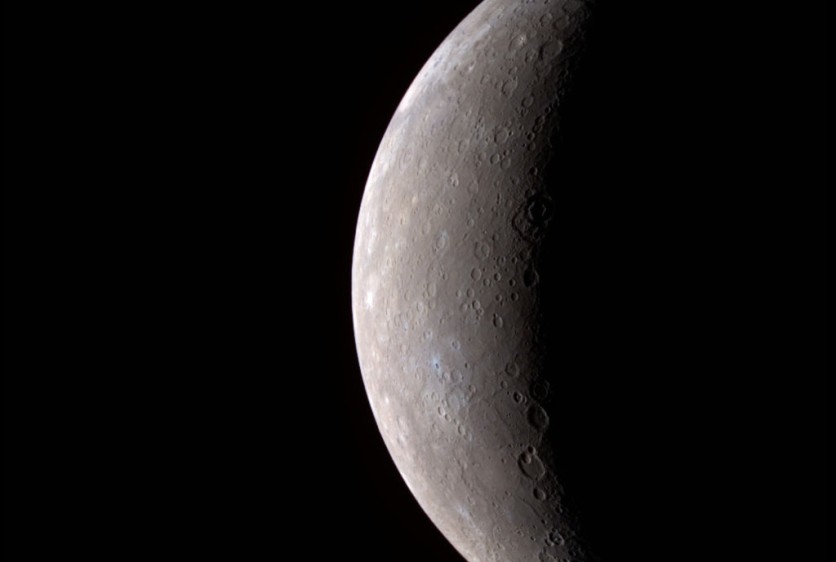Scientists have made an astonishing discovery about Mercury, the smallest and innermost planet in our solar system: some of its core might be made of diamonds.
This revelation comes from a recent study published in Nature Communications, conducted by researchers from China and Belgium (via Phys.org)

IN SPACE: In this handout from NASA, Mercury is seen from the Messenger spacecraft January 14, 2008. Messenger was about 17, 000 miles from the closest planet from the Sun on its first of three passes by Mercury before settling into orbit in 2011.
Scientists Say There Is a Diamond Layer in the Core of Mercury
In 2009, observations from NASA's MESSENGER spacecraft revealed notable amounts of graphite on Mercury's surface, leading researchers to speculate about the planet's early history and suggesting that Mercury once had a carbon-rich magma ocean.
Dr. Yanhao Lin from the Center for High Pressure Science and Technology Advanced Research in Beijing, a co-author of the study, took note of the high carbon content on Mercury and believed it indicated something extraordinary within the planet's interior.
Dr. Lin recalled that he had observed Mercury's unusually high carbon content many years ago and thought it could have significant implications. This observation led him to believe that unique processes likely occurred within the planet's interior.
The researchers propose that the boundary between Mercury's core and mantle, known as the core-mantle boundary (CMB), could include a diamond layer up to 18 kilometers thick.
This hypothesis challenges previous assumptions that graphite was the only stable carbon-bearing phase during Mercury's magma ocean crystallization.
Testing The Mercury Diamond Core Theory
To test their theory, Phys.org tells us that the scientists recreated Mercury's extreme interior conditions using high-pressure and high-temperature experiments.
They employed synthetic silicate to simulate Mercury's mantle composition, achieving pressure levels up to 7 Giga Pascals (GPa), roughly seven times the pressure at the deepest parts of the Mariana Trench.
These experiments provided insights into how minerals in Mercury's interior melt and reach equilibrium, focusing on the phases of graphite and diamond.
The team also used geophysical modeling to predict phase stability, calculate core-mantle boundary (CMB) pressures and temperatures, and simulate graphite and diamond stability under these extreme conditions. They estimated Mercury's CMB pressure at around 5.575 GPa.
Diamond, one of the hardest known materials, has a compressive strength of around 110 GPa.
Interestingly, the study found that sulfur in Mercury's core significantly affects the temperature range during the planet's cooling process. With about 11% sulfur content, there was a notable 358 Kelvin temperature change in Mercury's magma ocean.
This suggests that while graphite was likely the dominant carbon phase during the magma ocean crystallization, the cooling of Mercury's core led to the formation of a diamond layer at the CMB.
Dr. Lin noted that sulfur can lower the liquidus of Mercury's magma ocean, and if diamonds form in this environment, they could sink to the bottom and be deposited at the CMB.
One significant implication of this discovery is its potential impact on Mercury's magnetic field, which is unusually strong for its size. The high thermal conductivity of diamond helps transfer heat from the core to the mantle, affecting the generation of its magnetic field.
Stay posted here at Tech Times.

ⓒ 2025 TECHTIMES.com All rights reserved. Do not reproduce without permission.
![Best Gaming Mouse For Gamers With Smaller Hands [2025]](https://d.techtimes.com/en/full/461466/best-gaming-mouse-gamers-smaller-hands-2025.png?w=184&h=103&f=6fd057ef777bd39251d4e7e82e9b23f1)



![Best iPads that Students Can Use in School [2025]](https://d.techtimes.com/en/full/461431/best-ipads-that-students-can-use-school-2025.jpg?w=184&h=103&f=516289300e12e9647ef3d5bd69f49b70)